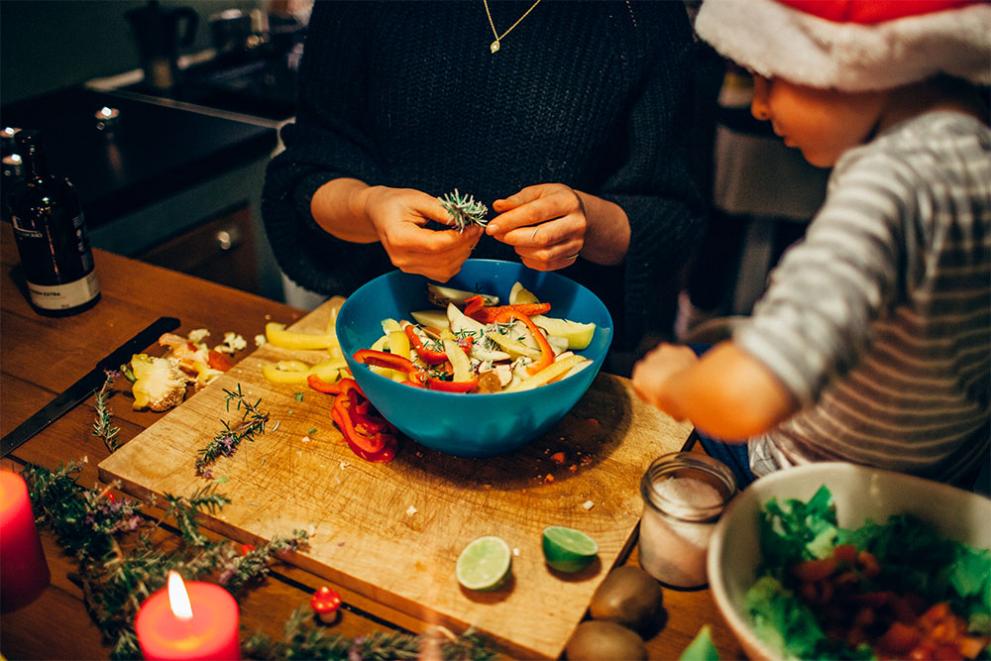
While the festive season is a time for treats, it also generates huge amounts of waste in the form of non-recyclable wrapping paper, plastic decorations and uneaten food. However, with a little prior thought, you can breathe new life into your leftovers. So here are our low-effort holiday hacks to lessen your festive waste!
#1: Make smart, sustainable and seasonal food choices
The first step to reducing food waste is to avoid overbuying, especially for perishable foods like meat and dairy, so think about how many people you’ll be cooking for every day. When shopping for food and drink, make sure that the fruit and vegetables you buy are seasonal and locally sourced. Clementines, apples, pears, cabbage, carrots, leeks and potatoes are all examples of food that is in season in the winter months. You can also limit packaging waste by opting for low-waste shops and bringing your own refillable containers, and make sure you recycle any plastic, glass or paper packaging you are left with.
#2: Less is more
At this time of year, it’s easy to over-indulge. One way to combat this is by letting people serve themselves at the table, which gives them control over how much they take and helps you to avoid the temptation to overfill their plates.
After the feast, pack up any leftovers in glass containers or beeswax cloth and store in the fridge or freezer. You could also incorporate the leftover ingredients into new creative recipes such as turkey curry or brussels sprout pesto. Keep a note on the fridge documenting what’s still to finish, so nothing gets forgotten about. Another key tip to avoid food waste is to research food donation schemes near you for anything you can’t manage.
#3: Look beyond tinsel, baubles and candy canes and opt for nature’s decorations
While plastic decorations garnishing your tree or mantlepiece can create a sense of festive ambience, did you know that a sustainable alternative can be found on your doorstep? Whether you’re tidying up the garden or going on a brisk winter’s walk in the countryside, consider foraging for beautiful decorations like pinecones, holly, ivy and mistletoe to bring nature into your home.
You can also make your own decorations, such as used cinnamon sticks, biscuits tied to a tree with ribbon or wine cork garlands. If you have any decorative lights, make sure they use low energy LEDs and don’t forget to turn them off before going to bed.
According to Climate Pact Ambassador Bogomila Traykova, there are sustainable variations of many decorations – including the tree itself. “You can find trees that are handmade and not plastic,” she says. “Trees made from paper or wood are great alternatives.”
#4: Wrap and re-wrap
The holidays are a time for giving and receiving, but in addition to sustainable gift ideas, there are ways to be even more green. Although wrapping paper adds a sense of mystery to a gift, all of it ends up in the bin. So why not wrap your gifts in fabric instead? You can repurpose cloth from old scarves, tea towels or other items using a Japanese tradition called ‘furoshiki’.
“I collect things all year long – from old bags to used sheets of paper – to wrap presents and make cards,” says Bogomila. “I try to avoid using plastic sticky tape and challenge myself to find ways to wrap without it. You’ll be surprised how creative you can be when you take away something as regularly used as tape!”
#5: Make New Year’s resolutions through the AWorld app
New Year, new start – why not continue repurposing your leftovers next year? The European Climate Pact has joined forces with ACT NOW, which has developed an app that helps you make waste reduction a daily habit. The AWorld app is full of climate-friendly tips and it counts each upcycling project, sustainable shopping choice and recycled glass bottle towards your positive impact on the environment.
Your actions will go a long way to help Europe become the first climate-neutral continent by 2050, so here’s your chance to make a big difference!
This article was originally published on 16 December 2021.
Details
- Publication date
- 4 December 2023
